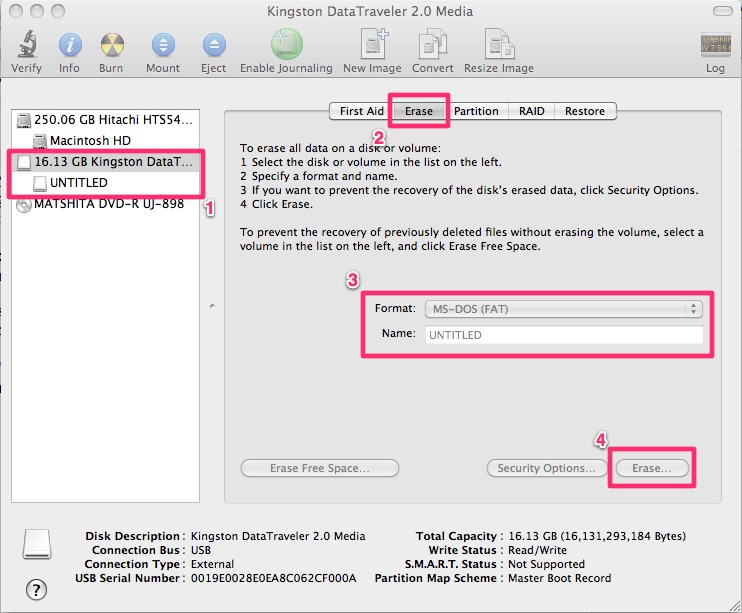

- FORMAT A USB STICK FOR MAC FOR MAC
- FORMAT A USB STICK FOR MAC MAC OS X
- FORMAT A USB STICK FOR MAC INSTALL
- FORMAT A USB STICK FOR MAC FULL
- FORMAT A USB STICK FOR MAC WINDOWS 10
To get started, all you need is an internet connection, a valid Windows 10 DVD and a USB stick of at least 8GB. This includes working with NTFS-formatted drives. Once set up, Windows 10 will function on your Mac in just the same way as it would on a regular PC. This allows you to boot both operating systems on your Mac. During the setup process, users shrink the size of their existing macOS installation to make room for Windows. The most recent version of macOS ( Mojave) supports Windows 10. You should now be able to edit existing files and copy new ones here.īootcamp is macOS’ own built-in utility for installing Microsoft Windows on your Mac. Open Finder, then click Go’> Go to Folder, then type ‘/Volumes/NAME’ where ‘NAME’ is the name of your NTFS drive.Ĭlick ‘Go’ to access your Windows disk. Next, connect your Windows drive to the Mac. Press Ctrl+O to save the list, and then press Ctrl+X to exit NANO. USB1 (if you’re unsure what this is, simply open Disk Utility): LABEL=NAME none ntfs rw,auto,nobrowse Use the arrow keys on your keyboard to scroll to the very end and add the following line, replacing ‘NAME’ with the actual name of your NTFS drive e.g. This will open the list of drives recognised by macOS. Connect your NTFS drive, then enter the command: sudo nano /etc/fstab To get started, click the Spotlight icon at the top right of your screen and enter ‘Terminal’.

As this feature is still in the testing phase however, your files could become corrupted at anytime, so proceed with caution. The main benefit of using Terminal in this way is that it’s quick to do and no third-party software is required.
FORMAT A USB STICK FOR MAC FULL
This is an experimental feature and could lead to data loss, so make sure to do a full backup of both your Mac and any data on the drive before continuing.
FORMAT A USB STICK FOR MAC FOR MAC
APM is an older, Mac-only partition scheme.If reformatting your NTFS drive for Mac is not an option, you can enable write support for specific Windows disks using macOS Terminal. You’ll also be asked to choose between a partition scheme: GUID Partition Map, Master Boot Record, or Apple Partition Map. RELATED: What's the Difference Between GPT and MBR When Partitioning a Drive?
FORMAT A USB STICK FOR MAC INSTALL
It’s not natively supported on many Linux distributions, but you can install exFAT support on Linux.įor external drives, it almost always makes sense to format in ExFAT, unless you’re using the drive for Time Machine. ExFAT is the ideal cross-platform file system. You should use this file system if you may share the drive with Windows PCs and other devices like the PlayStation 4 and Xbox One consoles. ExFAT: ExFAT is almost as widely compatible as older FAT file systems, but doesn’t have the limitations.MS-DOS (FAT): This is the most widely compatible file system, but it has some limitations–for example, files can only be 4GB or less in size each. Avoid this file system unless you have a device that requires FAT32.OS X Extended (Case-sensitive, Journaled, Encrypted): This is the same as the standard OS X Extended (Case-senstiive) file system, but with encryption.You’ll have to enter a password, and you’ll need to provide that password whenever you connect your drive to your Mac. OS X Extended (Journaled, Encrypted): This is the same as the standard OS X Extended file system, but with encryption.This option exists because it matches the traditional behavior of UNIX and some people might need it–don’t select this unless you know you need it for some reason.
FORMAT A USB STICK FOR MAC MAC OS X
By default, Mac OS X doesn’t use a case-sensitive file system.


 0 kommentar(er)
0 kommentar(er)
